Principles for Computer System Design
Butler Lampson
We have
learned depressingly little in the last ten years about how to build computer
systems. But we have learned something
about how to do the job more precisely, by writing more precise specifications,
and by showing more precisely that an implementation meets its
specification. Methods for doing this
are of both intellectual and practical interest. I will explain the most useful such method and illustrate it with
two examples:
Connection
establishment: Sending a reliable message over an unreliable network.
Transactions:
Making a large atomic action out of a sequence of small ones.
Principles for
Computer System Design
10 years ago: Hints for Computer System Design
Not that much learned since
then—disappointing
Instead
of standing on each other’s shoulders, we stand on each other’s toes.
(Hamming)
One new thing: How to build
systems more precisely
If
you think systems are expensive, try chaos.
Collaborators
Bob Taylor
Chuck Thacker Workstations: Alto, Dorado, Firefly
Networks: AN1, AN2
Charles
Simonyi Bravo wysiwyg editor
Nancy
Lynch Reliable messages
Howard
Sturgis Transactions
Martin
Abadi Security
Mike Burrows
Morrie Gasser
Andy Goldstein
Charlie Kaufman
Ted Wobber
From Interfaces to Specifications
Make modularity precise
Divide and conquer (Roman
motto)
Design
Correctness
Documentation
Do it recursively
Any
idea is better when made recursive (Randell)
Refinement: One man’s implementation is another man’s
spec.
(adapted from Perlis)
Composition: Use actions from one
spec in another.
Specifying a System with State
A safety property: nothing bad ever happens
Defined by a state machine:
state:
a set of values, usually divided into named variables
actions:
named changes in the state
A liveness property: something good eventually
happens
These
define behavior: all the possible sequence of actions
Examples of systems with state:
Data abstractions
Concurrent
systems
Distributed
systems
You
can’t observe the actual state of the system from outside.
All you can see is the results of actions.
Editable Formatted Text

This interface was used in the Bravo editor.
The implementation was about 20k lines of code.
How to Write a Spec
Figure out what the state is
Choose it to make the
spec clear, not to match the code.
Describe the actions
What they do to the
state
What
they return
Helpful hints
Notation is
important; it helps you to think about what’s going on.
Invent a suitable
vocabulary.
Fewer actions
are better. Less is more.
More
non-determinism is better; it allows more implementations.
I’m sorry I wrote you such a long letter; I didn’t have time to write a short
one. (Pascal)
Reliable Messages

Spec for Reliable Messages
q : sequence[M] := < >
status : {OK,
lost, ?} := lost
recs/r :
Boolean := false
(short for ‘recovering’)
|
Name |
Guard |
Effect |
Name |
Guard |
Effect |
|
||||
|
**put(m) |
|
append m to q, |
*get(m) |
m first on q |
remove
head of q, |
|
||||
|
*getAck(a) |
status = a |
status := lost |
|
|
then status := OK |
|
||||
|
lose |
recs or |
delete some element
from q; |
|
|
|
|||||
What “Implements” Means?
Divide actions into external
and internal.
Y implements X if
every external behavior
of Y is an external behavior of X, and
Y’s liveness property
implies X’s liveness property.
This expresses
the idea that Y implements X if
you can’t tell Y apart from X by looking only at the external actions.
Proving that Y implements X
Define an abstraction function f from the state of Y to the state of X.
Show that Y simulates X:
1) f maps initial states of Y to initial
states of X.
2) For
each Y-action and each state y
there is a sequence of X-actions that is the same externally,
such that the diagram commutes.

This
always works!
Delayed-Decision Spec: Example

The
implementer wants the spec as non-deterministic as possible,
to give him more freedom and make it
easier to show correctness.
A Generic Protocol G (1)

A Generic Protocol G (2)

A Generic Protocol G (3)

A Generic Protocol G (4)

G at Work

Abstraction Function for G
cur-q = <msg> if
msg ≠ nil and (lasts =
nil or lasts Î gr)
< > otherwise
old-q = the messages in sr with i’s that are good
and not = lasts
|
q |
old-q
+ cur-q |
|
status |
? if cur-q ≠ < > OK if lasts
= lastr
≠ nil lost if lasts
Ï (gr
È {lastr})
or lasts
= nil |
|
recs/r |
recs/r |
The Handshake Protocol H (1)

The Handshake Protocol H (2)
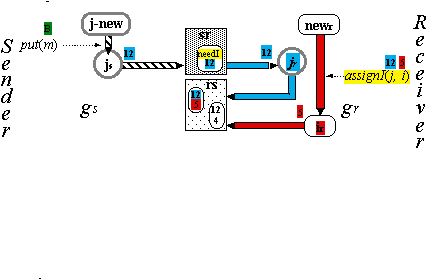
The Handshake Protocol H (3)

The Handshake Protocol H (4)

The Handshake Protocol H (5)
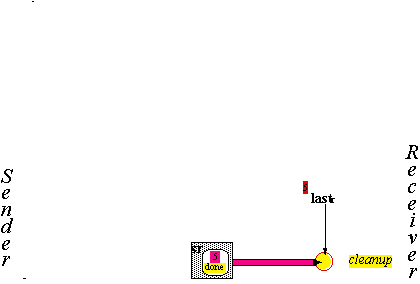
The Handshake Protocol H (6)
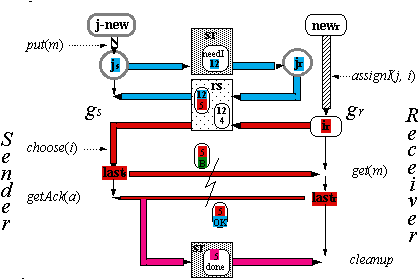
Abstraction Function for H
|
G |
H |
|
gs |
the i’s with (js, i) in rs |
|
gr |
{ir} – {nil} |
|
sr and rs |
the (I, M) and (I, A) messages in sr and rs |
news/r, lasts/r, and msg are the
same in G and H
|
|
|
|
growr(i) |
receiver sets ir to an identifier from newr |
|
grows(i) |
receiver sends (js, i) |
|
shrinks(i) |
channel rs loses the last copy of (js, i) |
|
shrinkr(i) |
receiver gets
(ir,
done) |
An efficient program is an exercise in logical brinksmanship.
(Dijkstra)
Reliable Messages: Summary
Ideas
Identifiers on messages
Sets of good
identifiers, sender’s Í receiver’s
Cleanup
The spec is simple.
Implementations are subtle
because of crashes.
The abstraction
functions reveal their secrets.
The subtlety can be
factored in a precise way.
Atomic Actions
|
|
S : State
|
Name |
Guard |
Effect |
|
|
|
|
|
do(a):Val |
|
(S, val) := a(S) |
A distributed system is a system in which I can’t get my work done because a
computer has failed that I’ve never even heard of.
(Lamport)
Transactions: One Action at a Time
|
|
S , s :
State
|
Name |
Guard |
Effect |
|
|
|
|
|
do(a):Val |
|
(s, val) := a(s) |
|
|
|
|
|
commit |
|
S := s |
|
crash |
|
s := S |
Server Failures
 S , s : State
S , s : State
f : {nil, run} :=
nil
|
Name |
Guard |
Effect |
|
begin |
f = nil |
f := run |
|
do(a):Val |
f = run |
(s, val) := a(s) |
|
|
|
|
|
commit |
f = run |
S := s, f := nil |
|
crash |
|
s
:= S, f := nil |
Note
that we clean up the auxiliary state f.
Incremental State Changes: Logs (1)
|
|
S , s : State S = S + L
L , l :
seq Action := < > s, f = s, f
f : {nil, run} := nil
|
Name |
Guard |
Effect |
|
begin |
f = nil |
f := run |
|
do(a):Val |
f = run |
(s, val) := a(s), l +:= a |
|
|
|
|
|
commit |
f = run |
L := l, f := nil |
|
. . . |
|
|
|
|
|
|
|
|
|
|
|
crash |
|
l := L, s := S+L, f:=nil |
Incremental State Changes: Logs (2)
|
|
S , s : State S = S + L
L ,
l :
seq Action s, f = s, f
f : {nil, run}
|
Name |
Guard |
Effect |
||
|
begin, do, and commit as before |
|
|
||
|
|
|
|
||
|
|
|
|
||
|
|
|
|
||
|
apply(a) |
a = head(l) |
S := S + a, l := tail(l) |
||
|
cleanLog |
L in S |
L := < > |
||
|
|
|
|
||
|
crash |
|
l
:= L, s := S+L, f:=nil |
||
Incremental Log Changes
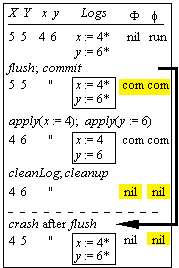 S , s : State L = L if f = com else < >
S , s : State L = L if f = com else < >
L ,
l :
seq Action f = f if f ≠ com else nil
F , f : {nil, run*, commit}
|
Name |
Guard |
Effect |
||
|
begin
and do as before |
|
|
||
|
flush |
f = run |
copy some of l to L |
||
|
commit |
f = run, L = l |
F := f := commit |
||
|
apply(a) |
f = commit, " |
" |
||
|
cleanLog |
head(L) in S |
L := tail(L) |
||
|
cleanup |
L = < > |
F := f := nil |
||
|
crash |
|
l := < > if F =
nil else L; |
||
Distributed State and Log
|
|
Si , si :
State f = run if all fi = run
Li , li : seq Action com if
any fi = com
Fi , fi :
{nil, run*, commit} and any Li ≠ < >
S, L, F are the products of the Si, Li,
Fi nil otherwise
|
Name |
Guard |
Effect |
||||
|
begin
and do as before |
|
|
||||
|
flushi |
fi = run |
copy some of li to Li |
||||
|
preparei |
fi = run, Li=li |
Fi := run |
||||
|
commit |
f = run, L = l |
some Fi
:=fi
:=commit |
||||
|
cleanLog
and cleanup as before |
|
|
||||
|
crashi |
|
li := < >if Fi = nil else Li; |
||||
High Availability
The F
= commit is a possible single point of failure.
With the usual
two-phase commit (2PC) this is indeed a limitation on availability.
If data is replicated,
an unreplicated commit is a weakness.
Deal with this by using a
highly available consensus algorithm for F.
Lamport’s Paxos algorithm
is the best currently known.
Transactions: Summary
Ideas
Logs
Commit records
Stable writes at
critical points: prepare and commit
Lazy cleanup
The spec is simple.
Implementations are subtle
because of crashes.
The abstraction
functions reveal their secrets.
The subtlety can be
added one step at a time.
How to Write a Spec
Figure out what the state is
Choose it to make the
spec clear, not to match the code.
Describe the actions
What they do to the
state
What
they return
Helpful hints
Notation is important;
it helps you to think about what’s going on.
Invent a suitable
vocabulary.
Fewer actions
are better. Less is more.
More
non-determinism is better; it allows more implementations.
I’m sorry I wrote you such a long letter; I didn’t have time to write a short
one. (Pascal)
Security: The Access Control Model
Guards control access to valued
resources.

Rules control the operations
allowed
for each
principal and object.
|
Principal may do |
Operation on |
Object |
|
Taylor |
Read |
File “Raises” |
|
Jones |
Pay invoice 4325 |
Account Q34 |
|
Schwarzkopf |
Fire three rounds |
Bow
gun |
A Distributed System

Principals
Authentication: Who sent a message?
Authorization: Who is trusted?
Principal — abstraction of
"who":
People Lampson, Taylor
Machines VaxSN12648, Jumbo
Services SRC-NFS, X-server
Groups SRC, DEC-Employees
Channels Key #7438
Theory of Principals
Principal says statement |
P says s
|
Lampson says “read /SRC/Lampson/foo”
SRC-CA says “Lampson’s key is #7438”
Principal A speaks for B |
A => B
|
If A says something, B says it too. So A is
stronger than B.
A secure channel:
|
says things directly |
C says s
|
|
If P is the only sender on C |
C
=> P |
Examples
Lampson => SRC
Key #7438 =>
Lampson
Handing Off Authority
Handoff rule: |
If A says B => A then B => A
|
Reasonable if A is competent and accessible.
Examples:
SRC says Lampson => SRC
Node key says Channel key => Node key
Any problem in computer science can be solved
with another level of indirection. (Wheeler).
Authenticating to the Server
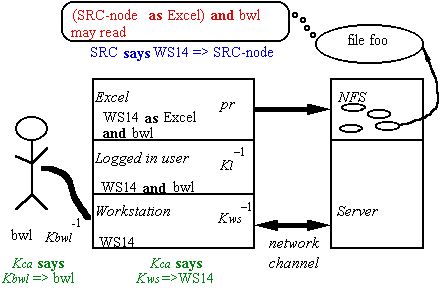
Access Control
Checking access:
Given a
request Q says
read O
an ACL P may read O
|
Check that Q speaks for P |
Q => P |
Auditing
Each step is justified
by
a
signed statement, or
a
rule
Authenticating a Channel
Authentication
— who can
send on a channel.
C => P; C is the channel, P the sender.
To get new C => P facts, must trust some principal,
a certification authority, to tell
them to you.
Simplest:
trust Kca
to authenticate any name:
Kca => Anybody
Then CA
can authenticate channels:
Kca says Kws => WS
Kca says Kbwl => bwl
Authenticated Channels: Example

Groups and Group Credentials
Defining
groups: A
group is a principal; its members speak for it.
Lampson =>
SRC
Taylor => SRC
. . .
Proving group membership: Use certificates.
Ksrc says Lampson => SRC
Kca says Ksrc =>
SRC
Authenticating a Group

Security: Summary
Ideas
Principals
Channels as principals
“Speaks for” relation
Handoff of authority
Give precise rules.
Apply them to cover many cases.
References
Hints Lampson,
Hints for Computer System Design. ieee Software, Jan. 1984.
Specifications Lamport,
A simple approach to specifying concurrent systems. Communications of the acm,
Jan. 1989.
Reliable
messages in Mullender, ed., Distributed Systems, Addison-Wesley, 1993 (summer)
Transactions Gray
and Reuter, Transaction Processing:
Concepts and Techniques. Morgan Kaufman, 1993.
Security Lampson,
Abadi, Burrows, and Wobber, Authentication in distributed systems: Theory and
practice. acm Transactions on
Computer Systems, Nov. 1992.
Collaborators
Charles
Simonyi Bravo: WYSIWYG
editor
Bob
Sproull Alto
operating system
Dover:
laser printer
Interpress:
page description language
Mel
Pirtle 940
project, Berkeley Computer Corp.
Peter
Deutsch 940 operating
system
QSPL:
system programming language
Chuck
Geschke Mesa: system
programming language
Jim Mitchell
Ed Satterthwaite
Jim
Horning Euclid:
verifiable programming language
Ron Rider Ears: laser printer
Gary Starkweather
Severo
Ornstein Dover: laser
printer
Collaborators
Roy
Levin Wildflower:
Star workstation prototype
Vesta:
software configuration
Andrew
Birrell, Roger Needham, Mike Schroeder
Global
name service and authentication
Eric
Schmidt System models:
software configuration
Rod
Burstall Pebble:
polymorphic typed language



